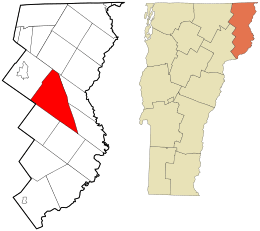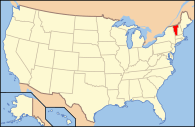Ferdinand, Vermont facts for kids
Quick facts for kids
Ferdinand, Vermont
|
|
|---|---|
|
Town
|
|

Location in Essex County and the state of Vermont.
|
|

Location of Vermont in the United States
|
|
| Country | United States |
| State | Vermont |
| County | Essex |
| Government | |
| • Type | (de facto) Unincorporated town |
| Area | |
| • Total | 52.8 sq mi (136.8 km2) |
| • Land | 52.6 sq mi (136.2 km2) |
| • Water | 0.2 sq mi (0.6 km2) |
| Population
(2020)
|
|
| • Total | 16 |
| • Density | 0.3/sq mi (0.1/km2) |
| Time zone | UTC-5 (EST) |
| • Summer (DST) | UTC-4 (EDT) |
| ZIP codes | |
Ferdinand is a small town located in Essex County, Vermont, in the United States. It was named after a German prince named Karl Wilhelm Ferdinand of Brunswick-Lunenburg.
Even though Ferdinand was officially recognized as a town, it was never formally organized. This means it never had enough people living there permanently to set up its own local government. Today, it is managed by a group called the Unified Towns & Gores of Essex County.
In 2020, only 16 people lived in Ferdinand. The most people ever recorded living there was 213 in 1910. Ferdinand is also part of the larger Berlin, New Hampshire – Vermont Micropolitan Statistical Area.
Contents
Exploring Ferdinand's Location
Ferdinand is found in the middle of Essex County. It shares its borders with several other towns. To the northwest is Brighton, and to the north is Lewis. On its eastern side, you'll find Brunswick and Maidstone. To the south, it borders Granby and East Haven. A small part of its southwestern edge touches the town of Newark in Caledonia County.
Roads and Rivers in Ferdinand
Vermont Route 105 is a main road that goes through the northern part of Ferdinand. This route connects Island Pond to the west with Bloomfield to the east.
The town covers about 136.8 square kilometers (about 52.8 square miles) in total. Most of this area, 136.2 square kilometers (52.6 square miles), is land. Only a small part, 0.6 square kilometers (0.2 square miles), is water. The Nulhegan River, which flows into the Connecticut River, crosses the northern part of Ferdinand from west to east. The highest point in the town is the top of Seneca Mountain, which stands at 3,170 feet (966 meters) tall.
People and Population Changes
Ferdinand has always been a very small town. Its population has changed a lot over the years.
| Historical population | |||
|---|---|---|---|
| Census | Pop. | %± | |
| 1860 | 34 | — | |
| 1870 | 33 | −2.9% | |
| 1880 | 40 | 21.2% | |
| 1890 | 73 | 82.5% | |
| 1900 | 41 | −43.8% | |
| 1910 | 213 | 419.5% | |
| 1920 | 106 | −50.2% | |
| 1930 | 18 | −83.0% | |
| 1940 | 17 | −5.6% | |
| 1950 | 10 | −41.2% | |
| 1960 | 16 | 60.0% | |
| 1970 | 14 | −12.5% | |
| 1980 | 12 | −14.3% | |
| 1990 | 23 | 91.7% | |
| 2000 | 33 | 43.5% | |
| 2010 | 32 | −3.0% | |
| 2020 | 16 | −50.0% | |
| U.S. Decennial Census | |||
Life in Ferdinand in 2000
According to the census from the year 2000, there were 33 people living in Ferdinand. These people lived in 13 different homes, and all of these homes were families.
About 23% of the homes had children under 18 living there. Most of the families (92.3%) were married couples living together. A small number (7.7%) were homes with a female head of household and no husband present. No homes were made up of single individuals.
The average number of people living in each home was about 2.54. The average family also had about 2.54 people.
Age Groups in Ferdinand
In 2000, the population of Ferdinand was spread out across different age groups:
- 21.2% were under 18 years old.
- 3.0% were between 18 and 24 years old.
- 15.2% were between 25 and 44 years old.
- 24.2% were between 45 and 64 years old.
- 36.4% were 65 years old or older.
The average age of people in Ferdinand was 54 years. For every 100 females, there were about 135.7 males.
See also
 In Spanish: Ferdinand (Vermont) para niños
In Spanish: Ferdinand (Vermont) para niños

